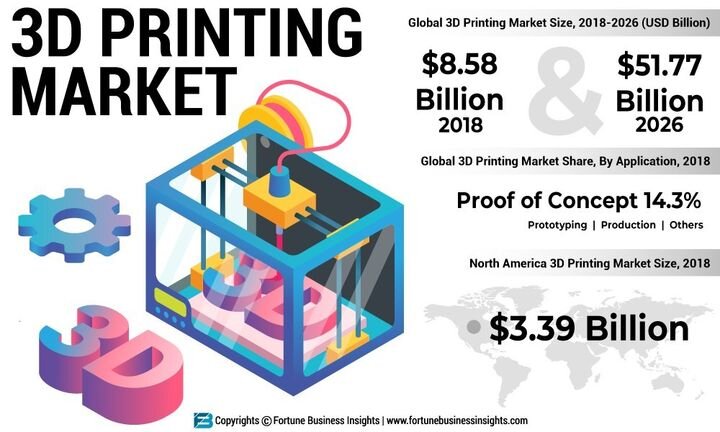![3D printing market forecast [Source: Fortune Business Insights]](https://fabbaloo.com/wp-content/uploads/2020/05/image-asset_img_5eb08be4e04bf.jpg)
Fortune Business Insights’ latest report indicates the 3D printing market will be US$51.77B by 2026.
Does this really mean anything?
Some will look at that number and shrug, thinking it’s just another business number not be concerned about. However, I feel that it is an extremely powerful motivator for those that see how things could play out in the future.
3D Print Market Growth
According to the same source, the 3D printing market in 2018 was US$8.58B. This is a large number, and of course supports all of today’s activity in the space. Remember, today’s world of 3D printing is the largest it’s ever been.
The 2026 number is 6X as large. And 2026 is only 5.something years away.
This number and growth factor suggests events such as these may occur over the next few years:
-
Some 3D printing companies will grow rapidly to become 5-10X larger than they are today
-
New 3D printing companies will appear and occupy some of that business
-
There is plenty of room for all players
3D Printing Entrepreneurs
Growth factors in this range are huge motivators for business entrepreneurs. They look at the number and say: “How big a slice of that can I get?”
They’re right – because a set of companies will take that business. It’s better to be one that does than one that does not.
3D Printing Venture Risk
Consider the opposite scenario, in which an entrepreneur is facing a business with a flat growth curve. In that case, the entrepreneur would somehow have to devise a means of taking market share from others who already have it. That’s often very challenging, particularly for new entrants whose products are not yet proven to the market at large.
That’s a much riskier situation than one in which there is essentially an open field where 83% of the market is up for grabs. The risk of failure is fantastically lower in a high growth scenario.
3D Printing Market Share
But you can’t just “grab” market share. You must have a compelling product and a sale & distribution system to deliver products and collect revenue. Those two things are not something that can be made instantly; they take considerable time to build and grow. Often it takes years to achieve, particularly at a large size.
How many years, exactly? In this case we have five years to do so, which is just about right for large-sized ventures.
The conclusion is that it is very likely we will see several large-scale 3D printing entrants appear in the next year or two, and I’m talking entrants of a size similar to Carbon or Desktop Metal, who each spent a few short years building to their new-immense sizes.
What will 3D printing look like in 2026? I don’t know, but it will be 6X bigger.
Via PRNewsWire

